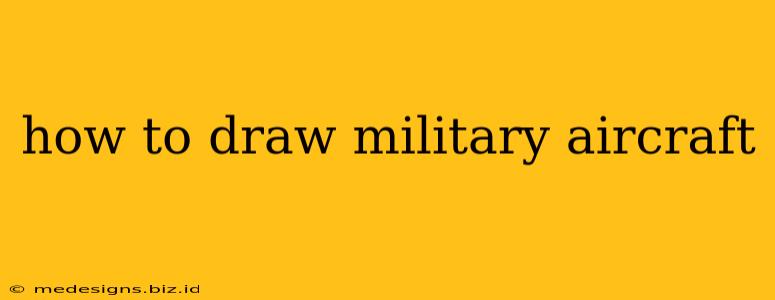Drawing military aircraft can be a challenging but rewarding experience. Whether you're a seasoned artist or just starting, this guide provides a step-by-step approach to help you master the art of depicting these powerful machines. We'll cover essential techniques, helpful tips, and resources to enhance your skills. Let's take to the skies!
Understanding the Basics of Military Aircraft Design
Before you start sketching, it's crucial to understand the fundamental design elements of military aircraft. This includes:
- Aerodynamics: Military aircraft are designed for speed, maneuverability, and efficiency. Understanding basic aerodynamic principles will help you accurately depict the shape and form of the aircraft.
- Key Features: Familiarize yourself with the distinct features of different aircraft types, such as fighter jets, bombers, helicopters, and transport planes. Note the variations in wings, fuselage, tail sections, and weaponry.
- Reference Images: Gather a collection of high-quality reference images from reputable sources. These will serve as your guide throughout the drawing process. Websites dedicated to military aviation, museums, and online image databases are excellent resources.
Choosing Your Aircraft: A Starting Point
Selecting the right aircraft for your first attempt is vital. Begin with a simpler design, like a classic jet fighter or a propeller-driven plane. More complex aircraft, with intricate details, are best tackled once you’ve developed foundational skills.
Step-by-Step Drawing Process
Let's break down the process into manageable steps:
1. Basic Shapes and Proportions:
- Start with Simple Shapes: Begin by sketching the basic shapes that form the aircraft's structure. Use light, loose lines to outline the fuselage, wings, and tail.
- Establish Proportions: Pay close attention to the proportions of each part relative to the others. Use light measurements or guides to ensure accuracy.
- Perspective: Consider the perspective from which you are drawing the aircraft. Is it a three-quarter view, side profile, or top-down perspective?
2. Refining the Details:
- Add Details Gradually: Once you're satisfied with the basic shapes, begin adding details like the cockpit, engines, landing gear, and weaponry.
- Refine the Lines: Gradually refine your lines, making them more precise and confident. Erase any unnecessary guidelines.
- Consider Texture: Think about the texture of different parts of the aircraft. Metallic surfaces have a smooth, reflective quality, while others may be rougher.
3. Adding Shading and Highlights:
- Light Source: Determine your light source. This will guide your shading and highlighting.
- Shading Techniques: Use shading techniques such as hatching, cross-hatching, or blending to create depth and dimension.
- Highlights: Add highlights to emphasize the reflective surfaces of the aircraft.
4. Final Touches and Refinement:
- Review and Refine: Step back and critically assess your drawing. Look for areas that need further refinement or adjustment.
- Add Final Details: Add any final details, such as markings, insignia, or weathering effects.
Tips for Success
- Practice Regularly: The key to improving your drawing skills is consistent practice.
- Experiment with Different Mediums: Try different drawing tools, such as pencils, charcoal, or digital art software.
- Study Other Artists' Work: Analyze the work of experienced aircraft artists to learn from their techniques.
- Join Online Communities: Connect with other aviation enthusiasts and artists online to share your work and receive feedback.
Resources for Learning
Numerous resources are available to enhance your skills, including online tutorials, instructional books, and workshops. Searching for "how to draw airplanes" or "military aircraft drawing tutorials" will yield many helpful results.
Conclusion
Drawing military aircraft is a fulfilling endeavor that combines technical skill with artistic expression. By following this guide and dedicating time to practice, you'll gradually develop your abilities and create impressive depictions of these magnificent machines. Remember, patience and persistence are key to mastering any artistic pursuit. Happy drawing!
